We are posting this “special” page of TastedOnline.com since so many of our friends have asked for more tales and photos about our travel adventures. So, if you have landed here by mistake or from a Google search just jump to the main site…TastedOnline.com. For those who want to follow our travel escapades we are going to post a short running commentary, along with photos, at each port or stop when we can get internet access on our T-Mobile hub. Our most recent trip is below and previous trips can be accessed using the specific links. So here is a quick snapshot of our two month cruise around South America on Cunard’s Queen Victoria. The most recent port is at the bottom so the trip is in the order we went if you view it top to bottom.
Free wine on a river cruise: what you need to know
Amsterdam to Budapest river trip.
Four and a half month cruse around the world on Cunard’s Queen Mary 2.
Selecting wine on the Cunard Queen Mary 2, or How to find the best value wine on a Cunard cruise.
Fort Lauderdale, Florida – San Juan, Puerto Rico
When we left the port at Ft. Lauderdale we were still on California time and use to the clear blue sky we’ve come to expect every day in Agoura Hills. As the sun set we left Fort Lauderdale in route to our first port, San Juan, Puerto Rico. During the two sea days Queen Victoria sailed within eyesight of Cuba’s North coast than proceeded by the island of Hispaniola that’s home to the Dominican Republic and Haiti. The weather was cloudy, temperatures mild and each day grew more humid. This was our first trip on the Queen Victoria, the smallest of the three Cunard ships and the passengers were primarily British. What we immediately noticed was the density of people in the public rooms is substantially less than we have experienced on the larger Queen Elizabeth or Queen Mary. This made for a much more relaxed and quiet travel experience.
We’ve never been to Puerto Rico before and had very few expectations for this visit. The ship docked within easy walking distance of the “Old San Juan” area so we simply meandered around looking at the sights and taking in local shops. Our first surprise was how clean and colorful everything was. Houses were simply delightful, streets were narrow and had old world cobble stone charm and at every intersection another interesting street would appear along with a continuing medley of Caribbean music.
|
|
|
From the ship we could see the modern city with its sparkling white buildings along the waterfront. We were told the best beaches in Puerto Rico were in this area and the broad sandy beaches were lined with new high-rise hotels. From the ship it was an easy walk to Fort El Morro, the 16th century fortress that guards the entrance to the harbor From there we walked along the linked fortifications just above the sea to Fort San Cristobal on the other side of the walled city. We didn’t find any wine shops, but since Puerto Rico is the world’s leading rum producer we did buy a locally made sample.
|
|
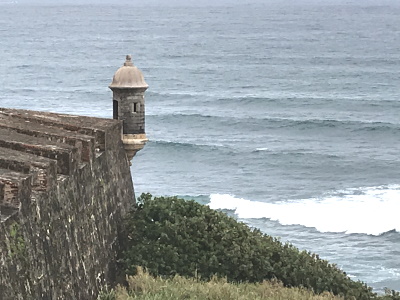 |
As we left San Yuan harbor we both commented that our first port turned out to be far more charming than we expected. It was a delightful visit to a new place. Now we’re off for one sea day meandering by Caribbean islands to the port of Bridgetown, Barbados.
January 24, 2020
San Juan, Puerto Roco – Bridgetown, Bardados
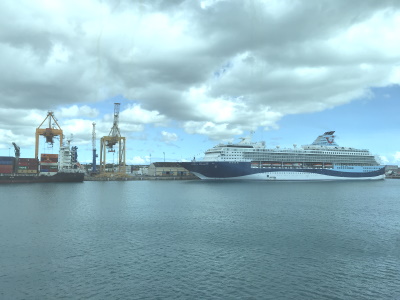
After a very leisurely sea day we arrived in Bridgetown bright and early on Sunday morning. There were several other cruise ships in the harbor with us; however everything but the arrival terminal was closed because it was Sunday. We walked into town (about a mile) along a very nice pedestrian path that ran along the shore and had a wonderful sea breeze blowing off the water. The only thing we found open was a very crowded restaurant/bar that overlooked the small harbor. Rather than wait for a table we walked around the downtown and went back to the ship for lunch.
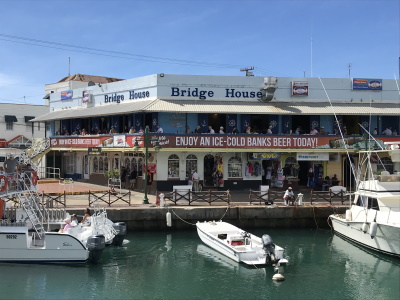
Our next stop is Manaus, Brazil. It’s located about a thousand miles up the Amazon River so we have four sea days to get there…although most of that time is spent trudging up the river were looking forward to some interesting travel time.
January 26, 2020
Bridgetown, Barbados – Manaus, Brazil
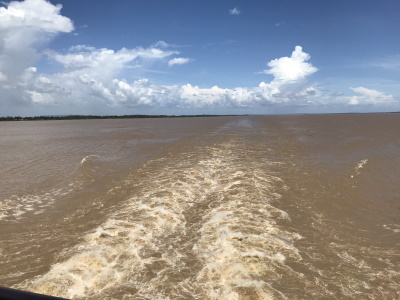
On our four sea days to Manaus it took almost two days to sail by Venezuela, Guyiana, Suriname and French Guyana, than as we approached the Amazon Delta the color of the water went from clear blue-green to brownish-red in color. It was tropical hot, in the 80’s, steamy humid with calm seas. Even after a day and a night traveling up the Amazon we still could only see the shore on one side of the ship…the word BIG does not even come close to describing the size of the Amazon River.
Almost all the sights in Manaus were within easy walking distance of the harbor. We first visited the famous opera house. Built in 1896 during the rubber boom when Manaus was known as the “Paris of the tropics”. It’s really an impressive architectural structure from the outside, but when we went in the opulent grandeur really shined. We took a short tour inside the building and were also very fortunate to attend a performance of the Amazonas String Orchestra that night.
 |
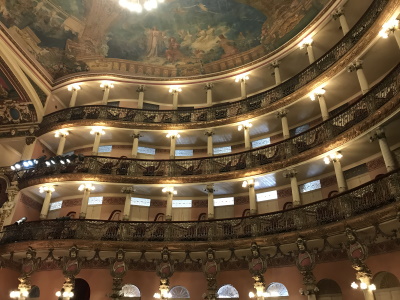 |
We also had a quick look at one of the original Manaus private residences that today has been transformed into the Rio Negro Palace Culture Center that’s used for musical recitals, dance and theater programs. Next we visited the Adolpho Lisboa Municipal Market that’s an iron Art Nouveau structure built in 1880 and today houses shops selling all kinds of local food and craft products from the Amazon region. Last we visited the Indian Museum that was filled with all kinds of artifacts that were used by the original Amazon people.
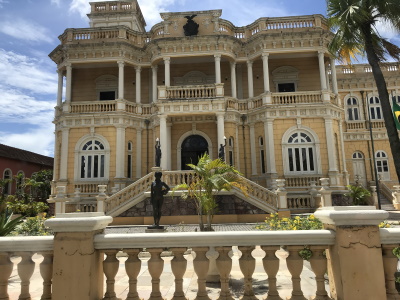 |
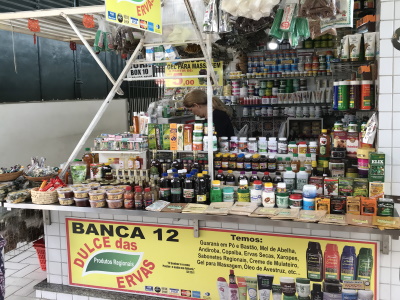 |
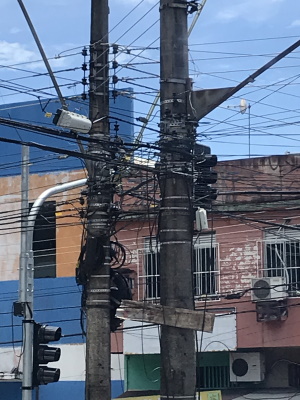
Manaus was one of the first cities in the world to have electricity, even before New York and Paris; however, the condition of the current electric system looks original and rather unkempt.
We had a very nice wine pairing lunch that compared four Chardonnay and four Pinot Noir wines from different locations around the world. Delicious, fun and very informative.
We’re now off on a one day sail to Santarem, Brazil that’s about 500 miles from the mouth of the Amazon.
February 1, 2020
Manaus, Brazil – Santarem, Brazil
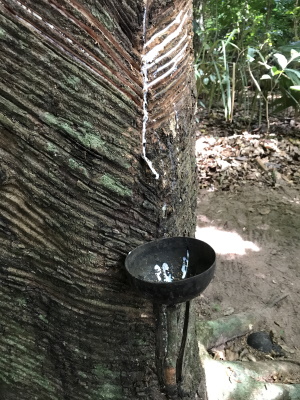
The ship really flew downstream and after our quick one day sail we arrived in the city of Santarem. It’s a port city right on the banks of the Amazon with a population of 300,000 and an economy based on lumber extraction, fishing, agriculture and mining . The city is located on an expanse of river that is 15 miles wide where the Amazon and the Tapajos rivers meet. Since it was Sunday and somewhat third-world we signed up to take a ship organized visit to an Amazon forest community about an hour out of the city. Although it’s a very minor activity we saw people collecting rubber from trees that were planted by Henry Ford when he tried to develop his own rubber plantation to make tires for his cars. Although Ford’s venture was not successful the trees he had planted are still growing in the reclaimed forest. In addition, people in this community were also harvest all kinds of fruits and nuts that we saw growing as we walked along forest paths.
 |
 |

Although Santarem was not a tourist mecca it did have lots of very interesting things to see if your interested in the Amazon rain forest. Because the economy is built around resource extraction and very little resource management, the landscape looks very used. Areas of forest have been cleared to grow soy beans and the mining industry, like everywhere else in the world, is not known for cleaning up it’s mess after the minerals are removed. When we spent a few weeks in the Peruvian Amazon jungle 30-years ago they were cutting giant mahogany trees, but little else was disturbed. Here outside of Santarem it has a very different look. Even with all this said, we both commented that we’re glad we visited Santarem as it gave us real insight into Brazil’s environmental problems as it grows and makes it’s way into the 21-century.
On the evening of our sea day we had a fantastic wine pairing dinner, OUTSTANDING food, GOOD wines…but, the wine was not up to any of the ones we brought aboard in Fort Lauderdale!!!
We’re now off for three sea days and the port of Salvador, Brazil, a port city on the Atlantic coast.
February 2, 2020
Santarem, Brazil – Salvador, Brazil
We left Santarem with a cast-off party as the sun set and Victoria began sailing through the muddy waters of toward the Amazon delta. The sea day weather was tropical…air and water temperature in the high 80’s with partly cloudy sky and occasional heavy wind and rain.
We did have two fun wine tasting events during these sea days. One included an assortment of South African wines made from classical grape varieties that were all surprisingly good. The other served ten different wines produced all over the world that was a real hodgepodge and a little difficult to make anything out of it, other than pick one or two that we liked best. These wines were served with excellent cheese and appetizers and had unlimited pours so we could go back and try the ones we liked. We also did a little side-by-side Sauternes tasting ourselves. Cunard was serving the “house” Sauternes (Chateau Petit Vedrines) at a special price ($6.95/glass) so we gave it a try one night. We liked it, but I noticed the ship also had Chateau d’Yquem Sauternes by the glass. We simply couldn’t resist ordering a glass of each and doing a side-by-side tasting with an apple tart for dessert. We told the sommelier not to identify them so we could drink them blind, but it was obvious which was which just from the color in the glass. And, as expected there was a DRAMATIC difference. We love Chateau d’Yquem and our side-by-side tasting really showed the difference between it and a “garden variety” Sauternes. In a word we described the Chateau Petit Vedrines as simply ephemeral!!!
|
|
|
Because all the interesting sights were in the upper historic city or Cidade Alta, Cunard ran shuttle buses directly from the ship to the center of the upper city and we spent the better part of the day strolling along the cobbled streets that were lined with Baroque buildings.
|
|
|
|
|
|
Although this colorful view of the city may be only in the artists eyes, Salvador was a very interesting and fun city to visit. It was founded in 1549, became the center of the slave trade in South America and you can still feel the pulsating strength and richness of the Afro-Brazilian roots. As we wondered the streets lined with 17th and 18th century architecture we could hear different groups of drummers pounding out rhythms at every turn.
We’re now off for one sea day then a two day visit to Rio De Janeiro, Brazil, about a 750 mile sail.
February 7, 2020
Salvador, Brazil – Rio De Janeiro, Brazil
We’ve been traveling south of the equator, yet as we sail along it appears to be getting warmer and more tropical, not colder. The sea is almost glassy smooth, both air and water temperatures in the mid-80’s with partly cloudy sky. It makes for very lazy sailing and only the most sun-starved Brit’s are out basking on the deck.
From what the Cunard tour staff told us there were two things not to miss when in Rio, Corcovado Mountain with the statue of Christ the Redeemer on top and Copacabana Beach. In addition we booked a tour to Petropolis that was about an hour out of the city, but it was canceled because the palace was closed on Monday. The Rio itself was quite striking with its high density of white high rise buildings and proximity between water and mountains.
|
|
|
We were in Rio on a weekend so getting around the streets was easy, but all the locals were with us at all the sights. The beach was literally filled beyond capacity…the locals take several coolers on hand trucks and set up a beach camp site for the day. We saw both Copacabana and Ipanema beaches and although I looked carefully I sure didn’t see the “girl from Ipanema” anywhere in the crowd!!!
|
|
|
Rio is a city of five million people and from what we knew about it we expected a wonderful port city that was comparable to Cape town or Sidney. However, it was large and commercial like most of the other major ports around the world. And the tour guides were right, seeing the beach was a true spectacle (but, we wouldn’t want to join the crowds for any sunbathing) and Corcovado Mountain was very special. From the cog railroad ride up the hill to the unbelievable views of the city beneath it was simply memorable. However, even with the city filled with history since 1502 (e.g., sugar cane and its slavery, gold, diamonds and coffee exports, the capitol of Portugal when Napoleon invaded and the capitol of Brazil until it moved to Brasilia in 1960) it didn’t have the endearing attraction most European cities provide for us.
We’re now off for two sea days and the port of Montevideo, Uruguay.
February 10, 2020
Rio De Janeiro, Brazil – Montevideo, Uruguay
Our two sea days to Montevideo were very quiet…several port talks, afternoon concerts and interesting lectures. Most remarkable item was one day out of Rio both the temperature and humidity completely turned around…were out of the tropics. The sea temperature was still 85 degrees F., but it was really just like Southern California weather to us.
Neither of us knew much about Uruguay, so our expectations were set very low. However ,we arrived on a clear sunny morning and sailing into the Montevideo harbor was nothing short of inspirational. With the sun to our backs and low rolling landscape with white buildings it was simply perfect. It’s really quite a low density city and sailing in you could see the close buildings in the city center and how quickly the density spread out. Again, not knowing about Uruguay we signed up to take a morning tour of the city, than about a 45-minute ride on a highway out into the Pampas countryside to the Famila Deicas Winery, the largest in Uruguay.
|
|
|
Our morning city tour took us through the downtown that was clean with wide tree lined streets and no traffic congestion!!! Business people were going to work in casual dress and it was just a relaxed Thursday morning in Montevideo and we both said WOW!!! I was really taken back with all the old buildings covered with French balconies, it was perfect Spanish colonial architecture.
|
|
|
The rainfall is more than Southern California and there were stands of trees and expansive grass lands. It’s an agricultural economy and we saw lots of cattle along with grapes and other fruit orchards. When we arrived at the Familia Deicas Winery, (see our wine tasting) formally the historic Janico Vineyard. it was surprising to see such an expanse of vineyards. We had a complete tour of the winery operation starting with rows and rows of Tannat grapes that were just about to be harvested. We saw them pressing grapes (by the ton) and then saw the original barrel cellar. Than we had a real treat…a sit-down wine tasting with lots of cheese, fresh bread and meats. We were served generous pours of five wines then you could taste any wines they produced and buy what met your fancy. The wines were GREAT and needless to say we bought all we could carry…nothing new!!!
As we sailed out of Montevideo we both said it was a Fabulous city, country and visit. In all honesty our tour guide was spectacular and she gave us lots of political, economic, cultural and historical information about both Montevideo and Uruguay. When you know practically nothing about the place your visiting, good information really helps you to understand and know it quickly. We would rate Montevideo VERY HIGH and would say Uruguay is a real sleeper, we really don’t know how such a wonderful country stays so hidden.
We’re now off for an overnight sail and two days in Buenos Aires. The sail tonight takes us across the mouth of the Rio de la Plata River…Montevideo is on the north side and Buenos Aires a little further up the river on the south.
February 13, 2020
Montevideo, Uruguay – Buenos Aires, Argentina
Our overnight sail to Buenos Aires very was quick and quiet, but the entrance to the port was SPECTACULAR with the rising sun to our back. Unfortunately we docked at a large container port and the view of the modern white buildings of the city was covered. Although we had two days in port, we had plans to visit a “dude ranch” type of Gaucho party the first day, visit the city parks and shopping the second day than off to a gala party that Cunard had for all the Round South America travelers. All of which were very pleasant and the sort of the experience we expected in Rio.
The first day we went to the Gaucho party at an ranch that was about a one hour drive outside of the city. There was a gaucho horseback riding show than horseback riding for the guests (who wanted to ride). We wondered the grounds and found a fantastic garden intertwined with all the buildings of the hacienda. Than our hosts tried to stuff us!!!! They served bottomless Argentine wine and grilled meats until everybody cried uncle all while the gauchos danced on the tables.
|
|
|
|
|
|
Our quick visit to the city was also a great experience. We had a good time comparing prices of items we buy at home, but the biggest surprise was how different some items were, both higher and lower. This is a city of 3.2 million people, yet it has a very low density feel. The streets were not congested and the numbers of the people on the shopping streets appeared very sparse to us…maybe were gettibg used to Califonia crowds.
|
|
|
Although our view from the ship left much to be desired, it was a really special port. The city was one of the cleanest, most modern and friendliest we have visited in South America. There was building construction going on everywhere you looked and it was clearly a very vibrant world class city. We give it a thumbs up and recommend everyone sailing the East coast of South America have a visit.
We’re now off for a two day sail to Puerto Madryn, Argentina and a visit to the largest Magellan penguin rookery in the world.
February 15, 2020
Buenos Aires, Argentina – Puerto Madryn
The southwestern sail to Puerto Madryn became more overcast every day with the air and water temperatures dropping into the mid-60’s. Without question each day looks more and more like winter. Puerto Madryn is a small city of about 70,000 people that’s nestled into the very protected harbor on the Gulf of Neuevo. There is a large fishing fleet here, but the main attraction is seeing the birds, whales, penguins and sea lions. We signed up for a trip to the Punta Tombo Penguin Reserve…the largest Magellan Penguin rookery in the world.
Puerto Madryn was quite compact and it only took about 10 minutes to reach the edge of the city and it went from urban to primitive wild in less than a 30-seconds. The climate is VERY dry and the landscape looks like central Wyoming with a sagebrush looking plant covering the ground. We went South for two and a half hours without seeing much human disturbance and the only life was occasional alpaca-like Guanacos and ostrich-like Darwin’s Reas. The penguin reserve had a gravel and boardwalk trail two or three miles from the shore that wondered through the rookery. Seeing the penguins was nothing like we envisioned. They nest in holes under the bushes or in the bear ground..
|
|
|
|
|
|
|
|
|
Seeing the penguins was a memorable experience and watching them walk over a mile from the water to their nests was quite endearing. Everyone likes to see animals in their natural habitat and in this case watching the penguins, guanacos and reas all in the same area was very special. The penguins having no fear of humans also made the experience unique.
We’re now off for a two day sail to Ushuaia, Argentina via Cape Horn and the Beagle Channel.
February 18, 2020
Puerto Madryn – Ushuaia, Argentina
The sail to Ushuaia turned out to be quite eventful. The clouds got heavier, and both the air and water temperature drooped well into the 50’s. The second day we had gale force wines from the south that slowed our progress. By the time we arrived at Cape Horn the winds had died down and we were able to come right up to the Cape Horn lighthouse…the very spot where countless ships have been lost or had to turn back because of the fierce winds and sea. In our case the sky was very ominous, but the wind and sea were calm.
Ushuaia has a population of about 45,000 with fishing being the primary economic base. Recently it has become known as tourist jumping off point for eco-tourism in the antarctic (seeing the ice melt must be a tourist attraction) and watching wildlife (e.g., penguins and sea lions) in the Beagle Channel. The eclectic architecture of the city is really fascinating and includes imported Swedish kit houses, old wooden houses covered with corrugated metal, and modern poured concrete structures. Since we had just come from seeing the penguins we decided to just take a stroll around the main streets of Ushuaia.
|
|
|
We enjoyed just wondering around the city streets and seeing how life goes on in this very remote part of the world. And were happy to report that here as in both California and North Carolina getting the kids ready to go back to school includes a Disney book bag!!!
Now we’re off for a one day sail that begins in the Beagle Channel than turns North to Punta Arenas, Chile.
February 21, 2020
Ushuaia, Argentina – Punta Arenas, Chile
We sailed out of the narrow Beagle Channel and along the coast within sight of land for almost a day, than into the Magellan Straits and the port of Punta Arenas. It was mostly sunny with 15-20 knots of wind, but the temperature was in the low 50’s. Punta Arenas overlooks the Strait of Magellan to Tierra del Fuego…the most southern point of land before you reach Antarctica. The city had its hay day around the turn of the century when it was the principal coal and supply port for ships rounding the Horn. It was one of the busiest ports in the world until the Panama Canal was built in 1914.
Queen Victoria anchored out and used the life boats to tender passengers into the city. We didn’t like any of the Cunard tours in Punta Arenas so we took a tender into the town and walked around. Since it was Sunday many shops were closed and it was 51 degrees and drizzling so it wasn’t the best conditions for a pleasant walk!!! However the French and Italian neoclassical architecture of the mansions around the square were in pristine condition and really showed off the city’s grand days. The city square was also unique with its numerous period Cedrus Dedora trees.
|
|
|
|
|
|
Except for the light rain we enjoyed just wondering around Punta Arenas main streets. It was a very clean city, the architecture was fantastic and we enjoyed our quick visit. Coming back on the tender we both commented that even though Punta Arenas is a city of about 150,000 people, it’s probably the most remote place we have ever visited.
Now we’re off for three sea days to Puerto Montt, Chile, with a sail-by of the Amalia Glacier and the Pio X Glacier on the way.
February 23, 2020
Punta Arenas, Chile – Puerto Montt, Chile
Leaving Punta Arenas we sailed out through the Magellan Straits into the Pacific and turned North for a one day sail to Amalia Glacier followed by second sea day to the PIO XI Glacier. All three of the sea days to Puerto Montt the had overcast weather with occasional showers, but the temperature was in the mid 40’s at the glaciers and in the high 50’s at Puerto Montt.
Our two stops at the glaciers were very interesting and revealing. Neither glacier was calving, but the giant POI XI had a face that was rounded, smooth and obviously melting faster than the one meter/day it was flowing. Vicky’s comment was that it looked like a dying beached whale. At both sites the weather was drizzly and foggy (as it is almost every day in this part of the world) so we couldn’t see the snow-capped mountains in the background or huge ice field that’s the source of both these and 47 other glaciers.
|
|
|
|
|
|
Now were sailing out of the fjord and back into the Pacific for another sea day to Puerto Montt.
After anchoring in Puerto Montt the captain announced that a tender (lifeboat) was in the water and testing to see if it was going to be possible to tender the passengers ashore with the 25-35 knot winds we were experiencing now. Very soon after he announced we would not be going ashore and were starting our sail to the next port of San Antonio, Chile. Puerto Montt is known for it fresh salmon and we were very disappointed that we couldn’t have a delicious salmon lunch with a fine Chilean wine while ashore, but it was just not to be this trip and we sure can’t see another trip around the Horn to get back to Puerto Montt!!!
The sun is coming out now and we’re off for a one sea day sail (that’s going to take us two days) to the port of San Antonio, Chile.
February 27, 2020
Puerto Montt, Chile – San Antonio,Chile
The cloudy weather is still with us, but every day gets a little warmer and were ready for the Mediterranean climate we expect at the next port. San Anatonio is the biggest Chilean coast fishing area and the busiest freight port on the west coast of South America.
We wanted to do some wine tasting in the Santiago wine region and since we were only in port one day we signed up for a Cunard trip that did a wine tasting and a short visit to Valparaiso. The 90-minute drive to Casablanca, where the vineyard was located had a very dry and barren landscape. However, the valley where the vineyard was located looked like an oasis with the drip irrigated grape vines. The winery had an old world Spanish setting and it turned out to be a fantastic vineyard tour and tasting. The wines were outstanding and they gave us a taste of any and all the wines produced. Needless to say we went wild with my Visa card and purchased as many bottles as we could carry. Watch for lots of four thumbs up reviews in the future!!!
|
|
|
We were glad we had the chance to see Valparaiso too. It was also a port city, but only had room for small cruise ships and was principally a container port. However, we were surprised to see how varied it was, from hillside communities to modern riviera style high rise buildings along the beach. If I had to describe it in a few words I would say it was like a third-world Cannes, France with its abundant restaurants and night-life.
|
|
|
Although we only did a drive-by of San Antonio the visit here was great. We tasted and purchased some very excellent Chilean wines and seeing both Valparaiso and the inland countryside was very interesting. We have a new appreciation of what “dry” means. Chile is about 5,000 miles long, but only about 100 miles wide so the climate and cities change very dramatically as we work our way north. We’ll remember this port as the gateway to a MEMORABLE wine adventure for us!!!
Now we’re off for an overnight sail to Coquimbo, Chile.
February 29, 2020
San Antonio,Chile – Coquimbo, Chile
The cold water and the warm air created a very foggy morning, but by afternoon the sun was starting to come through. Coquimbo is known for being a major shipping port for fruit, copper and wine and for its 300 feet tall Third Millennium Cross, the Cruz del Tercer Milenio. Since there wasn’t much for us in Coquimbo we joined a Cunard tour that included seeing some petroglyphs in the morning and a wine tasting in the afternoon.
We were excited about the wine tasting since it had been talked up in a port talk and was being heavily advertised by the ship tour office. The drive to the winery took us along the coast and through a very dry landscape where our tour guide told us the rainfall last year was only one inch of the normal three inches. I’ve see a lot of petroglyphs in western United States and really expected to see something similar, however they were very different. The petroglyphs were in a narrow dry stream bed that was used by nomadic people about 8,000 B.C. There were traditional rock carvings that looked like witch doctors or a mask they would use. The other form were holes about 10″-12″ deep carved into the rocks to form star formations or constellations.
|
|
|
When we arrived at the winery we could hardly believe what we were seeing. The facility was under an open air roof that covered a long ravine. Because it was open to the elements and temperature changes the barrels were just for show and the refrigerated tanks under the roof were actually used for wine production. Although our tour was given by the Cunard tour guide, we did see each step of the wine making process. When we went into the barrel cellar with stacks five and six high it was a little disconcerting since the area has frequent earth quakes. When we finally got to our tasting we were served one white and one red wine that were what we would call poor grocery store quality. Several people in our group wanted to purchase wine and asked if we could taste other wines and we were told “no, any purchase would have to be made without tasting the wines”. Needless to say not much wine was purchased and it was a disappointing wine tasting. Our comment was that this must be one of the Chilean vineyards that sell bulk wine that’s packaged in boxes for the U.S. market…our two tastes were not even that good, although it wasn’t sweet!!!
|
|
|
Our visit to Coquimbo was interesting and even though our wine tasting was really disappointing we’re glad we got to see this segment of the wine industry. We tasted some very excellent Chilean wines in Casablanca so our opinion of their wines is very positive. Coquimbo looks like an industrial port, but with it’s skyline dominated by the tallest monument in South America it does evoke strong memories.
Now we’re off for a one sea day sail to Arica, our last port in Chile. Arica is only 12 miles from the Peruvian border and we’ve been told that it’s a fantastic pedestrian city that’s filled with cafes and small shops…we can’t wait!!!
March 1, 2020
Coquimbo, Chile – Arica, Chile
Everything about Arica was WOW. When we sailed into the port it was a fog-free, a warm sunny morning, the air was crystal clear and the city was just off the dock. Although Arica has a population of about 200,000 people it was very low density and being located between the cold Pacific and the edge of the almost rainless Atacama Desert it is usually cloud free with an even temperature. After hearing how nice the city was we planned to just walk the pedestrian streets and what fun a fun day it turned out to be.
|
|
|
Walking through the pedestrian streets was an absolute delight. The major streets were lined with shops selling literally everything under the sun at good prices and the narrow streets were lined with outdoor cafes with chairs and tables under the spreading Ficus branches. We had a great time watching the world go by while sipping pisco sours, the national drink of Chile that’s made from a grape spirits, lemon juice, powdered sugar and beaten egg white. The warm breeze, delicious drinks and delightful ambiance just does not get any better and really made an impression on us!!!
|
|
|
Needless to say we sure had a good time just hanging out in Arica. We’re also finding our sea days are another treat. As we work our way along the South American coast were seeing lots of whales and dolphins. Yesterday a school of dolphins that must have been two miles long and one mile wide and contained hundreds of animals swam past the ship…it’s hard to imagine so many at one place at the same time!!!
Now we’re off for a one sea day sail to Callao, Peru. Callao is Lima’s port city and we’re there for two days.
March 3, 2020
Arica, Chile – Callao, Peru
Callao is the port city for Lima, Peru. It has a population of 1,000,000 people, but has merged with Lima into one large metropolis of about 9,750,000 inhabitants…about one third of Peru’s population. Callao is one of the few natural harbors along the Pacific coast of South America and the port was established by the Spanish in 1535. Since then it’s been a major port for goods produced in Peru, Bolivia and Argentina.
About 35-years ago we visited Lima for several days when we were in Peru for a Machu Picchu and Amazon jungle trip so we didn’t plan on going into Lima this trip. Cunard ran a shuttle bus to the Real Plaza Salaverry, a modern six-story shopping mall in an upscale suburb of Lima, so we gave that a try. We expected something with Peruvian character, but found a new mall filled with all the same store brands we have in all the U.S. malls. However, the one hour drive to the mall provided an interesting glimpse of Callao and suburbs of Lima.
|
|
|
|
|
|
|
|
|
Our two-day port in Callao/Lima was interesting and somewhat unusual. It was the most urban city-like port we visited this trip, it appeared that we docked in the middle of the largest container/freight port we have ever seen and Vicky found lots of fun Peruvian jewelry to buy right on the dock.
Next we’re off for a one sea day sail to Manta, Equador and summer weather again. On this sea day were going to a special wine dinner hosted by the ships head sommelier and prepared by the executive chef. It’s a gourmet dinner attended by about 20 people where they serve some of the best wines on the ship…YUM!!! ( see our review of a similar wine dinner we had on the Queen Elizabeth in 2013).
March 6, 2020
Callao, Peru – Manta, Equador
Manta is a major fishing port, but has very little tourist interest except possibly being the birthplace of the famous Panama hat. There is also a large U.S. military base in Manta which flys surveillance planes over the cocaine-producing areas in nearby Colombia. The city exports a large volume of agricultural products along with Panama hats and is the center of the country’s huge tuna fishing industry. Cunard ran tours to the beaches and a shuttle bus to a local mall, so we looked around the port area and went to the mall.
When we exited the port it looked like we were in Miami, with palm trees, new modern buildings and a manicured tropical landscape, To our surprise the mall was modern, but had mostly local brand stores and was definitely catering to the locals. We were there on Sunday morning and it was crowded with locals buying all kinds of everyday stuff as well as walking the mall and having ice cream.
|
|
|
|
|
|
|
|
|
When we came back to the ship for lunch we sat and watched huge sea turtles swimming near the dock and tons of tuna fish being unloaded from what appeared to be very high-tech fishing boats. They had huge nets, a very high viewing/control bridge and multiple small boats and helicopters on the deck. Manta, Equador was very cosmopolitan and much more affluent then we expected. At lunch we also watched a fleet of small sail boats racing around the buoys about a mile off shore. Although we’ve seen a small number of private sailboats at anchor in several South American ports, this is the first time we actually saw a large number enjoying the “rail-down” breeze and clear blue water.
This was a laid back port we both liked very much. Outstanding jewelry shopping and I even wound up with a nice Panama hat.
Now we’re off for a one sea day sail and the port of Fuerte Amador, Panama. We both commented that we’re getting back to civilization…the Equador authorities checked every passengers temperature before letting them step on the ground. Fortunately we didn’t hear of anyone who was not allowed to land and was put back on the ship!!!
P.S. The wine dinner last night was FANTASTIC and we probably don’t need to eat for at least a week. The food was very, very delicious and it was an eye-opening wine experience for us. Watch for a review of the dinner soon.
March 8, 2020
Manta, Equador – Fuerte Amador, Panama
Fuerte Amador is a coastal gateway port to Panama City and situated at the mouth of the Panama Canal. There wasn’t a dock so we anchored off Fuerte Amador and took life boats (tenders) back and forth to the shore. Looking south from our anchorage we can view about a hundred ships waiting for permission to proceed into the Canal. To our north we see the Manhattan-like skyline of modern Panama City.
Cunard offered lots of beach and jungle tours that didn’t interest us, so we took the tender into what appeared to be a small boat marina. On the ride in people were talking about a large wine and liquor store very close to the terminal we go through when landing. Needless to say there was nothing where the tender put us off, so we made a beeline to the wine store. It was large, but sold mostly grocery store wines and at prices higher than we pay in the grocery store in California. We had just done a lot of grocery store wine reviews and recognized many wines we purchased last winter, but they were all more expensive here in Panama. The store did have some $50 wines from Portugal, but when I saw a huge number of unopened cases of wine stacked in the front of the store next to a sunny window I just couldn’t bring myself to take a chance. Another thing that appeared a little fishy was the Bacardi rum had “Made in Mexico” printed on the label..
Again today the Panama port officials took the temperature of everyone before they boarded the tender. The good news is we didn’t see anyone get sent back, but people are getting concerned we may not be able to get off in Ft Lauderdale.
Now we’re off for a one sea day sail to the port of Cartagena, Columbia. During the day tomorrow we transit the Panama Canal and were told its quite exciting because the Queen Victoria squeezes through with only inches to spare…Sounds like fun since I’m not responsible for the scratches on the hull. Many years ago we went through the TVA Watts Bar lock with Antiope and believe me it was exciting when the lock operator opened the valve on 90′ of water.
March 10, 2020
Fuerte Amador, Panama – Cartagena, Columbia (Transit Panama Canal)
We left Fuerte Amador at day-break and were entering the Panama Canal by 7:15am. Cruise ships and those with a reservation have priority so we followed the planned schedule Cunard had set up. We have been through locks several times; however, going through the Panama Canal was not like anything we have experienced before. The scale of everything was overwhelming, seeing the size of the cuts that were necessary to get through the mountains made it look like an impossible task and then thinking it was all done in 1900 really puts it in perspective. It took all day do go from the Pacific to the Caribbean and we were fortunate to have a running discussion on the PA system as we went along The speaker had worked on the canal and both his father and grandfather were engineers who worked on the canal so he was knowledgeable and filled with historical lore.
There are three sets of locks, Miraflores and Pedro Miguel on the Pacific side and Gatum on the Caribbean side. The original locks include two parallel chambers so boats can continuously go either direction. There is a new, wider lock that runs parallel about a quarter of a mile from the original locks. Everything runs 24/7, but is limited to 35 lock operations/day because there is an ongoing drought in Panama. Water comes from Lake Gatun, the largest man-made-lake when it was built, but with the drought there isn’t enough water to keep the locks running at capacity.
|
|
|
|
|
|
|
|
|
|
|
|
|
|
|
Needless to say we really enjoyed our Panama Canal experience. Now for the rest of the story…As we sailed out into the Caribbean the captain made the announcement that officials in Cartagena, Columbia would not let passengers off the ship and we would be having a sea day instead of a day in Cartagena. So were on our way to Curacao, Republic of Curacao and expect to be there on Saturday, March 14th as planned. There is talk that we might stop at one of the other Caribbean islands tomorrow if Cunard can find dock space and a port that will accept cruise ship passengers!!!
There is also a growing foreign passenger concern that they may have problems getting off the ship in Ft. Lauderdale and catching a plane home. There is also suppose to be crew changes too. At this point it looks like the rest of our South America cruise may not go quite as planned.
March 12, 2020
Panama Canal – Oranjestad, Aruba
After getting the news that Cartagena would not let us land the Captain said he was in touch with Cunard in England and they were trying to find a replacement port. Late that night the captain said we were speeding up and would be in the port of Oranjestad, Aruba on Friday, than proceed overnight and be in Curacao on Saturday as planned.
We had never been to Aruba, but knew of the extensive refinery Standard Oil used to have on the island. Now it’s known for the beaches, casinos and laid back island life. We walked around the downtown that was less than a block from the dock. Lots and lots of jewelry, watches and local junk. We even found a wine store…they were selling $5 “Walmart” brand wines for $12-14!!! If we were into the sandy beaches we would have appreciated Aruba more.
|
|
|
Aruba was a pleasant stop and it was good to be back in a warm blissful climate again. Now we’re off for an overnight sail and the port of Curacao. The good news is that the only people on the ship who are sick just have the “Cunard cough” and were being told that everyone will be able to go ashore in Ft. Lauderdale when we arrive on the 17th. Since everyone on the ship has been away for more than 14 days they don’t need to be quarantined.
March 13, 2020
Oranjestad, Aruba – Willemstad, Curacao
We’ve been to Curacao 50 years ago and its grown into a much expanded modern Caribbean island. We took a short walk along the waterfront to the city, than a walk across the floating bridge and we were surrounded by 17th century gabled Dutch buildings all painted in wild pastel shades of color. Being the last stop we were in the buying mood, but found the stores to be pretty much what we have at home and not nearly the bargain jewelry, camera and watch prices we remember from our previous visit. In fact we found a wine/liquor store that was selling Walmart Barefoot wine at $16-18 and had a selection of $20+ wines that included Yellow Tail and other similar brands.
|
|
|
Well were off for two sea days and then back to our Ft. Lauderdale starting point. This seemed like a two week trip it went so fast, but thinking back we covered a lot of sea miles and visited many places we never dreamed about going to. The only thing we missed was rough, stormy weather when going around Cape Horn, but than again maybe even that may be a good thing.
We commented this morning that if we had not gone on this trip we would be siting in California right now facing a plane trip back to North Carolina and with the lack of the U.S. preparedness for Covid-19 that would not be a fun trip for us.
March 14, 2020
Just a short update before our last travel post: Ft Lauderdale – Kernersville, North Carolina.
Cunard has given the passengers notice that due to Covid-19 Queen Victoria will dock long enough to disembark Ft. Lauderdale passengers and take on supplies then immediately depart for the home port of Southhampton and temporarily suspend any new cruises. Our car is waiting for us near the dock in Ft Lauderdale and hopefully will be ready for the dash home!!!
Ft Lauderdale – Kernersville, North Carolina
After hearing the horror stories of going through Covid-19 immigration we were very surprised to get practically pushed through. There was not a temperature check, no questions about where we had been, no agricultural form or customs check…just instructions to open our passport to the picture page, than a quick stamp and a good bye. It was faster than it took me to write this sentence!!! Our car was waiting for us in the long-term parking lot and we we simply drove home without any problems. We stopped twice for food and to our surprise both places had their tables and chairs against one wall, but other than that everything was as expected…even all the northerners on I95 going home from their Florida winter vacation.
Great trip and we can’t wait till the next one!!!
March 15, 2020